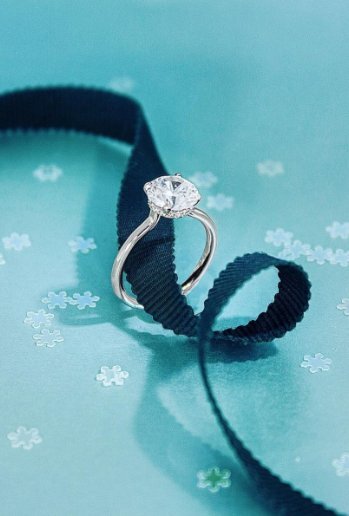- Home
- / 4 C’s of diamond
4 C’s of diamond
The Cut Performance Tutorial discusses the AGS ASET and Ideal-Scope’s This Precision Tutorial discusses the Optical Symm or Hearts &Arrows Viewer. All diamonds look nice under bright lights, but most become noticeably average in normal conditions. Those which continue to sparkle and dance have good cut quality. At Numined we separate cut quality into two areas; Cut Performance, which revolves around light return, and Cut Precision which can take top performing diamonds to an even higher level.

Micro Cut Precision first became possible in the late 1980s in rounds and is only now surfacing in fancy shapes. This is a measure of how well all of a diamond’s facets align with each other in 3D. It takes improved tools, more time and higher skill sets to accomplish top precision. More importantly it expends more carat weight. When present in top-performing diamonds, cut precision can boost contrast, dispersion, scintillation and overall performance in low-light conditions.
Cut Precision is seen in reflective Optical Symmetry viewers, also known as Hearts & Arrows Viewers. These scopes use a single color and no back lighting to show physical cut alignment. Where other viewers focus only on the crown view, the optical symmetry viewer shows both crown (top) and pavilion (bottom) views. Note: These are not performance reflectors. They reveal nothing about light return, which is a prerequisite for cut precision to have benefits. Read about the AGS ASET and Ideal-Scope’s in our Performance Tutorial.

How do Optical Symmetry and Hearts & Arrows Viewers work? The diamond is set face-down to see pavilion cut precision. It is turned over, face-up, to see crown cut precision. When the viewer is placed over the diamond light from above is coded white and light from the sides is coded red (other colors may be used).
When the diamond is cut so exactly that its facet reflections overlap with each other it produces uniform, kaleidoscopic patterns in the viewer. Only a tiny fraction of the world’s diamonds will show crisp, uniform patterns.
Pavilion: With the diamond upside-down the overlapping reflections create a pattern of eight symmetrical hearts in the pavilion. It takes six perfectly aligned facets to create a single heart. If any facet is off the entire pattern will be distorted.
Crown: Turn the diamond over and you will see eight radiating arrows in the crown. Each arrow is a reflection of two perfectly aligned pavilion mains. The arrows are much easier to achieve than the hearts, so the hearts view is most important.
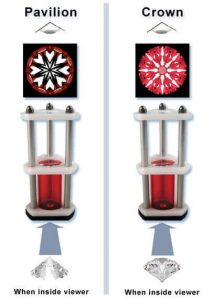
Different Shapes have Different Standards: Fancy cuts are not held to the same standards as Round Brilliants. The crisp uniformity of patterns seen in precisely cut rounds is not possible with more complex facet arrangements. As a result shapes other than round are practically never discussed in terms of cut precision. However, as the benefits of cut precision are studied by research labs and made known to consumers we are confident cut-focused manufacturers will begin to pay attention to their development.
Princess Cut: Depending on configuration, a princess cut will have between 24-48 facets on its pavilion and 17-29 cut on the crown. This makes for a wide variety of looks even when the patterns are readable. The princess cut below has a 24 facet pavilion (known as 2-chevronÂ).
Pavilion: With the diamond upside-down the overlapping reflections create a series of white and red Ves in the pavilion. It takes eight perfectly aligned pavilion facets to create a single V and reflections from other quadrant can impact uniformity. Perfectly symmetrical patterns are rare in diamonds of common sizes (0.50-3.00 cts) but each quadrant can be well-aligned.
Crown: Turn the diamond over and you will see a primary X running through the crown. This is a reflection of four perfectly aligned pavilion mains. A series of symmetrical white reflections indicates alignment of the other crown facets.
Analysis: While the colors do not indicate levels of light return (AGS ASET and Ideal-Scope can be used for this) they show how well a diamond’s facets align with each other in 3D. Where other viewers focus only on the crown view, the optical symmetry viewer shows both crown (top) and pavilion (bottom) views.
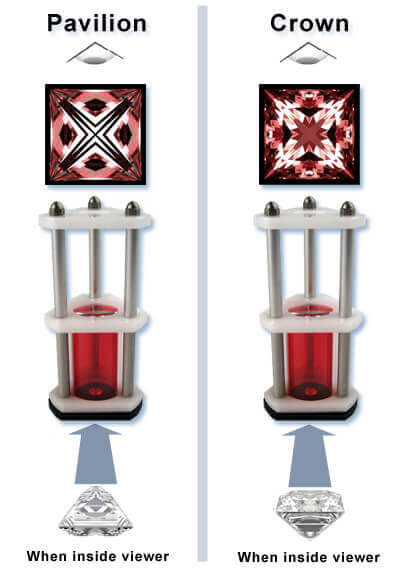

Round Brilliant Examples in Optical Symmetry Viewer

Princess Cut Examples in Optical Symmetry Viewer
Benefits of Cut Precision: Cut Precision fine-tunes diamonds which already enjoy top performance. The better-defined contrast pattern creates sharper on-off scintillation and more primary colors in dispersion (less pastels and earth tones). Precision cutting maximizes the return of all available light, even in softer lighting conditions. This is a logical result of all of the facets, the tiny mirrors inside the diamond, brought into precise alignment with each other. Face up color is also improved when light gets in and out of a diamond with more intensity. This can be noted in many diamonds with above-average performance. High performance coupled with top cut precision enhances the effect even more.
Why don’t more stores have these viewers? Because few diamonds remotely approach this level of precision. All diamonds look nice under bright lights and these viewers reveal the lack of precision present in the vast majority of the world’s diamonds.
Why are not more diamonds cut like this? A high level of micro-precision takes modern tools and more time to achieve. It also requires polishing away more carat weight. Assembly-line factories with dated equipment would have to sacrifice more time and produce smaller diamonds to do this, costing millions in time and carat weight. Remember that most consumers are barely aware of how to judge cut quality. Only a single digit percentage of the world’s diamonds are even cut for top performance. Far fewer have both top performance and top precision; easily fewer than 1% of all rounds and perhaps 0.01% of princess cuts.
Conclusion Cut Performance should be a prerequisite for Cut Precision. Understanding that, diamonds which enjoy high performance and precision are dizzying, dazzling and rare treasures to behold. In fact, because of factory cost-effectiveness and lack of public awareness the performance & precision standards that we insist on make every one of our diamonds rarer than a D Flawless in terms of cut quality.
All diamonds look nice under bright lights, but most become noticeably average in normal conditions. Those which continue to sparkle and dance have good cut quality. At Numined we separate cut quality into two areas; Cut Performance, which revolves around light return, and Cut Precision which can take top performing diamonds to an even higher level.
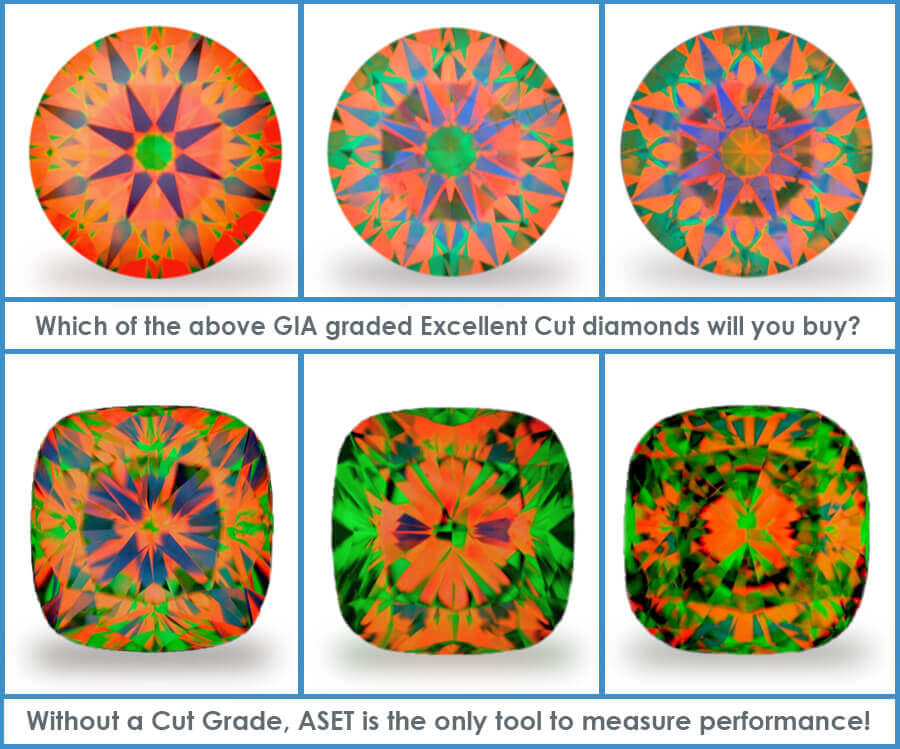
Cut Performance Performance resulting from cut quality has been studied and developed since the 1800s. Traditional components include brightness (all light returning to the eye), dispersion (seen as white light is broken into spectral colors) contrast (the pattern of dark and light areas) and scintillation (sparkle seen as the diamond, the light source or the observer move).
Diamond Performance is elegantly seen in the AGS ASET and its precursor, the Holloway Ideal-Scope’s. These tools are performance reflectors developed in factories & laboratories to improve cut performance. They are not sales tools. The AGS ASET is the only diamond cut grading tool endorsed by the science community.
How do ASET and Ideal-Scope’s work? Light entering a diamond will (a) reflect from the pavilion and return to the viewer’s eye or (b) through the pavilion. These performance reflectors, when placed over a diamond, allow a viewer to see where light is returning to the eye and where it is leaking, as well as a contrast pattern which is critical to scintillation. Simple to use, both devices do this naturally and effectively. The ASET does reveal more detail, making it preferable for fancy shapes.

The Ags ASET The AGSL began cut grading diamonds in 1996, after 30 years of research by the AGS Diamond Grading Standards Committee. Their Angular Spectrum Evaluation Theory or ASET, introduced in 2005, is the foundation of their three-dimensional cut grading system and the AGS Ideal light performance grade.
Here is the hand-held version of the AGS ASET, with backlight. The diamond is placed on the backlight and the unit is placed over the diamond.
Light entering the crown is now color-coded Red is Direct Light (drawn from 45-75 degrees). Red will be the most intense. It comes directly from the source. green is Reflected Light (drawn from 0-45 degrees). Green has less intensity. It is light reflected from walls, the environment, etc. Blue represents light Obscured by the observer (your head blocks this light from reaching the diamond). These areas will light up when the diamond is tilted and other areas will become shaded.

White (if the diamond is backlit, as above) or Black (if not) is Leakage. These areas show where pavilion facets are acting as windows rather than mirrors. You see white because those windows allow you to look through the diamond and see the light underneath. White should be minimized.

What to look for In general Red should be maximized. Some Blue is necessary. Too much Green is undesirable. The distribution of the three colors is important. White should be minimized.

Round Brilliant Examples High Performance (Rounds) In high performance rounds Red is dominant, broken by an even Blue contrast pattern. Green is present in small, symmetrical quantities. white leakage should be minimized.
Brightness and Dispersion Abundant Red indicates abundant light return, which most people find appealing. The balance of dispersion or fire acirc seen will depend on the diamond’s configuration or make it a large tables and shallow crowns have more whiteness then fire. Small tables and high crowns have more fire than whiteness. Middle combinations are balanced.
Contrast Blue creates the contrast pattern in a round diamond. These areas are obscured by the observer in the face-up position. Tilt the diamond slightly and those areas erupt in light as others go dark. Tilt it more and they swap again. Keep tilting and the on-off sparkle you see is scintillation. In high performance diamonds the character of scintillation is influenced by the table and lower halves. Short lower halves result in fewer, broader flashes. Long lower halves create more numerous, smaller flashes. Middle combinations are balanced.
The Ideal-Scope Garry Holloway’s Ideal-Scope has been the world’s most widespread performance reflector since the early 2000s. A simpler version of the Ags ASET (a precursor by several years) the Ideal-Scope is employed by trade buyers looking to match diamonds quickly as well as numerous internet shoppers and cut enthusiasts. The Ideal-Scope is simple to use and understand and well-suited to judgments in rounds.
ASET Color Coding Red: Direct Light, most intensity Green: Reflected Light, lesser intensity Blue: Light Obscured by the observer White (backlit): Leakage
Ideal-Scope Color Coding Red: All Light Return, Direct & Reflected(no green, red covers that spectrum)Black: Light Obscured by the observer white (backlit): Leakage
Round Brilliant Examples in ASET and Ideal-Scope The performance qualities in round brilliants are predominantly direct light (Red in both tools) contrast pattern (Blue in ASET, Black in IS) and leakage (white in both tools) so both tools are well-suited to analyzing rounds.
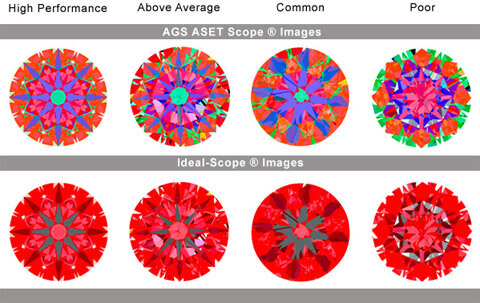
Resources Both tools provide simple, elegant and 100% natural ways to analyze light performance. For interested consumers, a USA distributor selling both of these instruments and a variety of other diamond-related tools is Accredited Gem Appraisers in Philadelphia.
Why don’t more sellers have these tools? Because few diamonds achieve top light return. All diamonds look nice under bright lights and these tools reveal the cutting flaws that are present in the vast majority of the world’s diamonds.
Why aren’t more diamonds cut for Performance? Because its cost-effective to follow the shape of the rough. Even a few tenths of a degree away from the critical angles which produce optimum performance produce less brightness and leakage.
Conclusion Performance reflectors reveal a great deal about the brightness, contrast and scintillation-potential of a diamond. With a small amount of study even a novice can learn how to judge Cut Performance with these performance reflectors.
The most important thing to know about color when it comes to diamonds is, in general, the less color a diamond has, the more valuable it is, all other factors being equal. Diamonds are found in nature in a wide range of colors, from completely colorless (the most desirable trait) to slightly yellow, to brown. So-called a fancy color diamonds TM come in more intense colors, like yellow and blue, but these are not graded on the same scale.
The color grading system for diamonds uses the letters of the alphabet from D through Z, with a TM being the most colorless and therefore the rarest and most valuable, and a having the least color within the normal range, and being the least valuable, all other factors being equal. A diamond’s color is determined by looking at it under controlled lighting and comparing them to the Gemological Institute of America’s color scale, which is based on a set of diamonds of known color. Here is a diagram showing how a diamond,s color is graded:
Fancy colored diamonds
make up a small but exotic part of the diamond industry. These diamonds include red, blue, green and pink as well as the stronger yellows. Red, Pink and green are the rarest fancy colors. They also come in combinations such as orange/yellow or gray /blue. These stones are expensive and quite rare. A fancy red one-carat stone can run up to $1,000,000, depending upon the beauty of the stone.
Another vital grading characteristic in diamonds is their clarity. This refers to the number, position and size of the inclusions that occur naturally inside diamonds. The fewer and less obvious the inclusions, the more valuable the diamond. Here is an illustration showing the clarity grading scale that has been established by the world™s foremost authority on diamonds, the Gemological Institute of America (GIA). Note: Diamonds are shown under 10X magnification: Flawless. Rarest of all clarities; If a diamond is viewed under 10X magnification and does not exhibit any internal inclusions as well as external blemishes, the diamond is considered Flawless by an experienced diamond grader. If one is seeking the ultimate clarity in their diamond, they shall take into consideration that diamonds in the ultimate in clarity grade are very rare, thus highly prized for their beauty and rarity.

